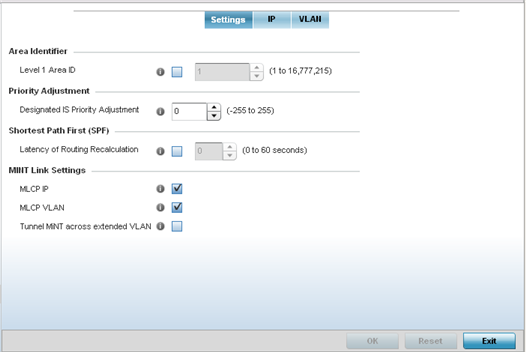To define a profile's MiNT settings:
Select MiNT Protocol from the Advanced Profile's menu item.

The Settings tab displays by default.
Refer to the Area Identifier field to define the Level 1 and Level 2 Area IDs used by the profile's MiNT configuration.
|
Level 1 Area ID |
Select the check box to enable a spinner control for setting the Level 1 Area ID between 1 - 4,294,967,295. The default value is disabled. |
Define the following Device Heartbeat Settings in respect to devices supported by the profile:
|
Designated IS Priority Adjustment |
Set a Designated IS Priority Adjustment setting from -255 and 255. This is the value added to the base level DIS priority to influence the Designated IS (DIS) election. A value of +1 or greater increases DISiness. The default setting is 0. |
Select the Latency of Routing Recalculation check box (within the Shortest Path First (SPF) field) to enable the spinner control used for defining a latency period from 0 - 60 seconds. The default setting has the check box disabled.
Define the following MiNT Link Settings in respect to devices supported by the profile:
|
MLCP IP |
Check this box to enable MiNT Link Creation Protocol (MLCP) by IP Address. MLCP is used to create one UDP/IP link from the device to a neighbor. The neighboring device does not need to be a controller, it can be another access point with a path to a controller. |
|
MLCP VLAN |
Check this box to enable MLCP by VLAN. MLCP is used to create one VLAN link from the device to a neighbor. That neighboring device does not need to be a controller, it can be another access point with a path to a controller. |
Select Tunnel Controller Load Balancing (Level 1) (if available to your controller) to enable load balancing through a WLAN tunnel controller.
If Tunnel Controller load balancing is enabled for your controller, enter the name of the designated WLAN tunnel controller.
Select OK to save the changes made to the Settings tab. Select Reset to revert to the last saved configuration.